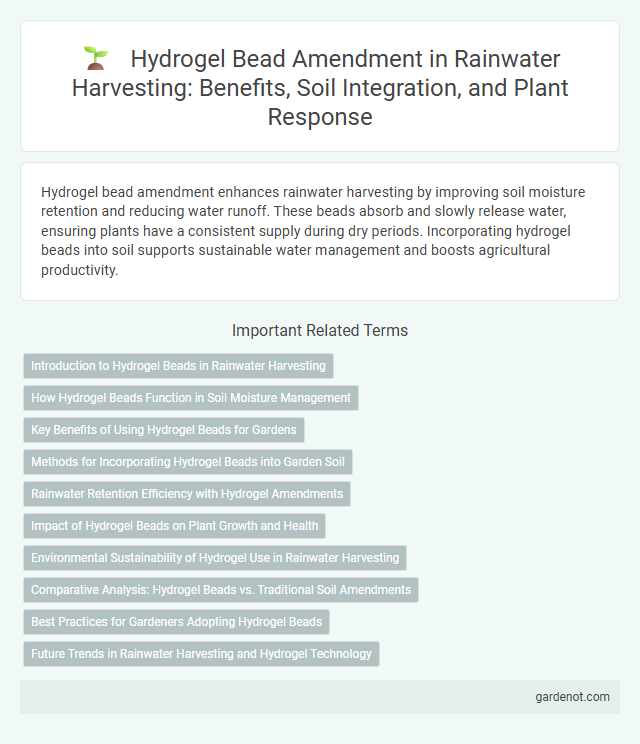Hydrogel bead amendment enhances rainwater harvesting by improving soil moisture retention and reducing water runoff. These beads absorb and slowly release water, ensuring plants have a consistent supply during dry periods. Incorporating hydrogel beads into soil supports sustainable water management and boosts agricultural productivity.
Introduction to Hydrogel Beads in Rainwater Harvesting
Hydrogel beads enhance rainwater harvesting by absorbing and retaining large volumes of water, increasing soil moisture availability during dry periods. These polymer-based beads swell upon water contact, gradually releasing moisture to plant roots and reducing runoff, improving water use efficiency. Their integration into soil systems optimizes rainwater retention and supports sustainable irrigation practices in arid and semi-arid regions.
How Hydrogel Beads Function in Soil Moisture Management
Hydrogel beads absorb and retain large quantities of water, slowly releasing moisture into the soil to enhance water availability for plants during dry periods. They improve soil texture by increasing porosity and reducing compaction, which promotes better root growth and nutrient uptake. These beads reduce irrigation frequency and water runoff, contributing to efficient rainwater harvesting and sustainable soil moisture management.
Key Benefits of Using Hydrogel Beads for Gardens
Hydrogel bead amendment enhances rainwater harvesting in gardens by significantly improving soil moisture retention, reducing irrigation frequency, and promoting healthier root development. These beads absorb and slowly release water, optimizing water availability during dry periods and minimizing runoff. Their use leads to water conservation, increased plant resilience, and overall improved garden productivity.
Methods for Incorporating Hydrogel Beads into Garden Soil
Incorporating hydrogel beads into garden soil enhances water retention by absorbing and slowly releasing moisture to plant roots. Common methods include mixing hydrogel beads directly with dry soil before planting, applying them around root zones during transplanting, or combining beads with compost for improved nutrient and water synergy. Proper integration ensures optimal distribution of hydrogel beads, maximizing their effectiveness in rainwater harvesting and reducing irrigation frequency.
Rainwater Retention Efficiency with Hydrogel Amendments
Hydrogel bead amendments significantly enhance rainwater retention efficiency by absorbing and storing large volumes of water within soil matrices, reducing surface runoff and evaporation losses. These polymer-based hydrogels release moisture gradually, improving soil water availability during dry periods and supporting plant growth. Field studies demonstrate that soils treated with hydrogel beads can increase water retention capacity by up to 40%, optimizing rainwater harvesting outcomes in arid and semi-arid environments.
Impact of Hydrogel Beads on Plant Growth and Health
Hydrogel beads enhance plant growth and health by improving soil moisture retention and nutrient availability, leading to increased root development and higher biomass production. Studies reveal that hydrogel amendments reduce water stress during drought conditions, promoting consistent plant vigor and chlorophyll content. These benefits contribute to improved crop yield and resilience, making hydrogel beads a valuable tool in sustainable rainwater harvesting practices.
Environmental Sustainability of Hydrogel Use in Rainwater Harvesting
Hydrogel bead amendment in rainwater harvesting significantly enhances water retention and soil moisture levels, reducing the frequency of irrigation and conserving water resources. These superabsorbent polymers contribute to environmental sustainability by minimizing runoff, mitigating soil erosion, and promoting groundwater recharge. Biodegradable hydrogels further decrease ecological impact, ensuring long-term soil health and supporting sustainable agricultural practices.
Comparative Analysis: Hydrogel Beads vs. Traditional Soil Amendments
Hydrogel beads significantly enhance soil moisture retention compared to traditional amendments, increasing water availability by up to 40% during dry periods. Their polymer-based structure allows for controlled water release, reducing irrigation frequency and improving plant growth efficiency. Unlike conventional organic or mineral soil amendments, hydrogel beads maintain soil aeration and prevent nutrient leaching, optimizing both water use and nutrient uptake in rainwater harvesting systems.
Best Practices for Gardeners Adopting Hydrogel Beads
Gardeners adopting hydrogel bead amendment should ensure even soil mixing to maximize water retention and promote consistent moisture availability. Applying hydrogel beads in appropriate dosages based on soil type prevents waterlogging and supports optimal plant root development. Regular monitoring of soil moisture levels helps adjust bead application, enhancing rainwater harvesting efficiency in garden landscapes.
Future Trends in Rainwater Harvesting and Hydrogel Technology
Hydrogel bead amendment is emerging as a transformative innovation in rainwater harvesting by enhancing soil moisture retention and improving water use efficiency. Future trends indicate the integration of smart hydrogel composites with controlled release capabilities, enabling optimized water delivery in arid and semi-arid regions. Advances in biodegradable and environmentally friendly hydrogel materials are expected to drive sustainable water management practices in agriculture and urban landscaping.
Hydrogel bead amendment Infographic

 gardenot.com
gardenot.com